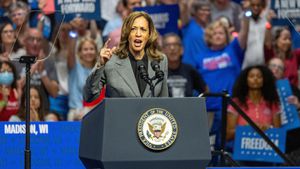The 2024 U.S. presidential race is heating up, and all eyes are on the pivotal battleground states. With the outcome likely to be decided by the slimmest of margins, candidates Donald Trump and Kamala Harris are positioning themselves to secure not only their party bases but also key swing voters. This election season, it’s these uncertain areas, comprising usually of volatile voting blocs, where the battle for the presidency will be fought, and both candidates are inching closer to victory with strategies catered to these voters.
Historically, battleground states have held the key to the electoral college, and this year seems no different. Observers project the election will hinge on roughly seven states: Arizona, Georgia, Michigan, Nevada, North Carolina, Pennsylvania, and Wisconsin. Each of these states possesses unique demographics and concerns, shaping the strategies of both campaigns as they vie for these increasingly important votes.
Arizona, for example, flipped from red to blue in 2020, and again, it’s being monitored closely due to pressing issues like immigration and abortion rights. Meanwhile, Harris' recent campaign stops signify her commitment to reclaiming voters who backed Biden just four years earlier. But as Harris presses the flesh, polls show Trump is gaining traction, especially among Latino voters—a group once leaning more toward Democrats.
Georgia, too, has become pivotal. It went blue for the first time since 1992 during the last election. The Republican Party is determined to flip it back, focusing on increasing turnout among rural voters and re-energizing African Americans who supported Biden last time. Trump is expected to bolster his campaign here by tapping these rural votes, which could prove decisive.
Another noteworthy state is Michigan, which holds significant sway with its large Arab-American population. This demographic is disenchanted with Biden's handling of Middle Eastern affairs, presenting Trump with yet another opportunity to gain ground. Harris needs to sharpen her focus on grassroots initiatives to keep those voters engaged and invested.
Nevada is also considered somewhat of a swing state, having consistently voted Democrat since 2008 yet still offering up only six electoral votes. Current sentiments suggest the economy will dominate discussions, making labor unions and their influence pivotal this election. The unions, with their capabilities to mobilize and persuade, can tip the scales significantly within the state.
North Carolina presents its own challenges. It has not backed a Democratic presidential nominee since Obama’s win back in 2008. With Harris making strides to close the gap, the state’s controversies, particularly surrounding lieutenant governor Mark Robinson, could have far-reaching consequences on Trump’s chances here.
Much attention is also thrown on Pennsylvania, where Trump initially flipped the state, famously winning it by less than 1% in 2016. Recent data suggests it might be another tough battle, as both candidates seek out voters with targeted messages focused on the economy—one of the top concerns among the state’s residents.
Importantly, Wisconsin appears to tilt slightly toward Harris, but as with other states, pressing issues such as healthcare and crime present hurdles she needs to overcome to maintain her lead.
Notably, statewide polls indicate Trump holding slight leads across several battlegrounds, with Arizona showing him up by five points, Georgia leaning four points his way, and North Carolina barely within the margin of error at 49% to 47%, according to recent polling from The New York Times and Siena College. Despite Harris’ attempts to bridge the gap, the vote remains very much up for grabs, leaving both campaigns to strategize accordingly, focusing heavily on undecided voters whom they see as pivotal.
Suburban voters, particularly affluent and educated demographics responsive to the candidates’ outreach efforts, could also play defining roles across these states. To lock them down, both sides are investing heavily, from traditional advertising to grassroots mobilization efforts. Harris is banking on energizing younger voters, facing off directly against Trump’s narrative aimed at older demographics.
The economic narrative leans heavily toward inflation concerns, which seem to universally trouble voters across all demographics. High costs of living drive discussions, with both candidates shaping their messages around cost management and consumer support. Harris argues her approach focuses on middle-class needs, defending her plans to cap rent and lower grocery costs, whereas Trump seeks to leverage increased prices to showcase his economic management style.
Underneath the whirlwind of economic rhetoric lie larger questions about the stability of the electoral system itself—a concern brought to prominence following the last election. Both parties grapple with the potential for chaos as states prepare to certify their votes, following what some saw as tumultuous challenges back in 2020. Voter turnout will be of utmost importance, particularly as new voting laws continue to mold how ballots are counted.
Lessons from previous elections resonate: every single voter counts, and both campaigns are aware of their need to mobilize every last potential supporter. The 2020 contest illustrated how minor, fractional shifts can create polar reversals. Hence, candidates are scouring their electoral maps, targeting undecided independents who remain pivotal to determining outcomes, particularly evident in states like North Carolina, where independents have had the power to swing elections.
With just weeks to go until election day, the strategy for both campaigns is as clear as it is complex. The stakes couldn’t be higher, as voters prepare to head to the polls. This tight race, filled with unprecedented events and unpredictable voter behavior, is set to keep candidates on their toes as dynamics shift across the country.
The narrative of the 2024 U.S. presidential election is still being written, but with the clock ticking, the battleground states and swing voters may just decide who takes residence at 1600 Pennsylvania Avenue come January 2025.



